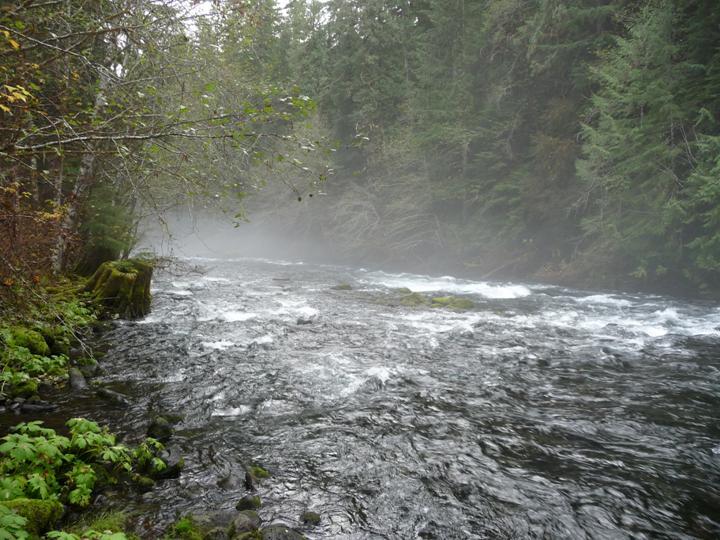Trail Bridge Reservoir Passage Project

This project will facilitate conservation of bull trout Salvelinus confluentus in the upper McKenzie River basin. Bull trout is a federally listed salmonid that commonly exhibits a migratory life history entailing movements up to several hundred kilometers between rearing and spawning habitats. Being iteroparous, bull trout may repeat spawning and undertake multiple migrations during a lifetime. Persistence of bull trout populations requires accessibility of habitats necessary for completing all life stages and connectivity among populations to provide for genetic exchange (Rieman and McIntyre 1993). Reestablishment of connectivity is a pervasive element in bull trout conservation efforts and constitutes a primary objective of the federal recovery plan for bull trout in the Willamette River basin (USFWS 2005).
Extant local populations of bull trout in the upper McKenzie and South Fork McKenzie basins historically comprised elements of a larger meta-population, but construction of Trail Bridge Dam on the McKenzie River and Cougar Dam on the South Fork McKenzie River isolated populations above these dams. Construction of upstream and downstream fish passage facilities at Cougar Dam (USFWS 2008) began in April 2009. A recently negotiated multi-party settlement agreement requires the Eugene Water & Electric Board to construct upstream and downstream fish passage facilities at Trail Bridge Dam (Eugene Water & Electric Board 2008). The settlement agreement also requires Eugene Water & Electric Board to maintain bull trout populations above the dam during the construction period and provide for fish access into and out of spawning tributaries upstream of Trail Bridge Reservoir. Drawdown of Trail Bridge Reservoir during construction of fish passage facilities will likely result in increased downstream passage of bull trout over the spillway and through the penstock, while preventing upstream migration from the reservoir into spawning tributaries upstream from the reservoir (also referred to as “Carmen Bypass Reach”). The settlement parties expect the Federal Energy Regulatory Commission to issue a license consistent with the settlement agreement, and although the construction phase will not begin until 2012 (assuming Spring 2010 license issuance), the migratory life history of bull trout (out-migration from natal streams at ages 0 to 4, additional 1–3 years of rearing in reservoir or main stem before returning to spawn at age 5 or older) provides impetus for initiating this project in 2009.
This project involves monitoring distribution, abundance, and movements of bull trout in the upper McKenzie River basin, our goal being to conserve spawning populations upstream of Trail Bridge Dam by facilitating movements past the dam and between spawning tributaries and main stem habitats. We will use a variety of active and passive sampling gears to capture juvenile and adult bull trout within Trail Bridge Reservoir and tributary streams. Captured fish will be marked with PIT tags to provide unique identification for each individual. Use of tagging and detection histories will enable recognition of bull trout that originated in populations upstream from Trail Bridge Dam, thus facilitating transfer of adults caught downstream of the dam to their natal spawning tributaries, when deemed appropriate.
By operating remote PIT tag interrogation systems, we will also detect movement among tributary and main stem habitats, providing needed data on life history, habitat use, and degree of intermixing among populations. This project will provide four primary benefits: (1) tagging and recapture of bull trout will provide a means to conserve populations of bull trout upstream from Trail Bridge Dam during years of reservoir drawdown for construction; tagging bull trout in tributaries downstream of the dam will provide for identification of bull trout that should be released downstream of the dam; (2) fish surveys and investigation of movement patterns will yield information on bull trout distribution, abundance, life history attributes, corresponding habitat requirements, and limiting factors, before and during the construction period; (3) baseline data on bull trout movements and development of an extensive population of tagged fish will facilitate assessment of efficacy of passage facilities after construction, and (4) connectivity and interchange between the upper McKenzie and South Fork McKenzie basins will be monitored.
These data will provide the basis for assessing the immediate and long term effects of providing volitional fish passage facilities at Trail Bridge Dam. By maintaining bull trout populations upstream of Trail Bridge Dam and supporting connectivity among populations and among habitats in the McKenzie River basin, this work will enhance efforts to conserve and recover bull trout as specified in the bull trout Recovery Plan (USFWS 2005), the Biological Opinion for the Willamette Project (USFWS 2008), and the Upper Willamette Basin Bull Trout Action Plan (UWBTWG 2009). This project will also complement ongoing work in the McKenzie River basin funded by the U.S. Army Corps of Engineers.